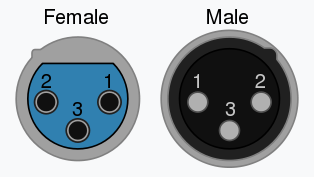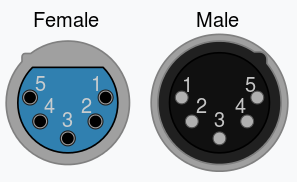Introduction to DMX
Hardware Layer
DMX512 is typically employed over relatively long distances due to the distance between the lighting booth and stage. The further a signal is sent, the longer distance you have available to pick up stray electromagnetic interference from the surrounding area. Combine this with the fact that DMX is usually used in electrically noisy environments and we have to settle on a solution that is relatively noise free, so DMX employs RS-485.
Signals like this are interpreted by reading the difference between one wire with the data (D+), and another wire with the inverse of the data (D-). Since we are reading the difference, we call this a differential signal. Differential signals like RS485 pick up noise almost equally along the two signal lines, this keeps the difference between the two signals the same. Since we read the difference between the two signals, it's easy to communicate over long distances (The DMX standard recommends a maximum run of a thousand feet, although RS-485 is rated for 4,000 feet).
DMX data is typically transferred over an XLR-5 cable, although occasionally, DMX capable XLR-3 cables are also used. RS-485 only requires 3 lines, ground, Data+, and Data-; and in many applications, this is all that was used. However, an additional pair of data lines was added to allow for future growth, requiring the XLR-5 cable. These connectors and their pinouts are shown below.
| Pin | XLR-3 | XLR-5 |
|---|---|---|
| 1 | Common | Common |
| 2 | Data 1 - | Data 1 - |
| 3 | Data 1 + | Data 1 + |
| 4 | N/A | Data 2 - |
| 5 | N/A | Data 2 + |
An issue that arises with the communication over distance is that DMX devices are usually powered far away from each other. These distances this can result in ground loops; differences in voltage between the ground potentials of two devices which, if high enough, results in current flow between devices. Due to this distance, the DMX512 standard also calls for opto-isolation between the microcontroller and DMX portions of the circuit on a DMX fixture.
It is also wise to fit a 120Ω termination resistor between the two data lines at the extreme end of the chain of DMX devices to prevent signal reflection. Some devices have a switch, some will suggest you plug in an XLR cable with a terminating resistor attached, while others simply won't have one at all. An unterminated DMX line can cause flickering in your whole Universe, so be sure the line is terminated.

